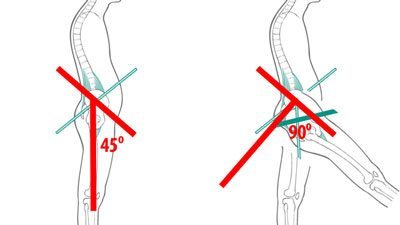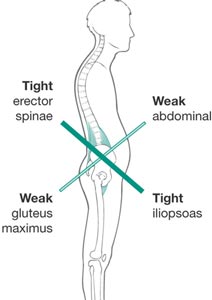Several months ago I featured a couple of posts discussing the importance of hip flexion strength and how to assess and enhance hip flexion strength. Since then, I have receive a lot of feedback from people saying that they have been working on their hip flexion strength but feel that they still don’t have good functional hip flexion strength when doing the step over FMS test or the functional hip flexion test:
There is one more reason that you may be struggling with this in addition to the lack of strength and dynamic stability that I previously discussed that centers around mobility.
If you look at the picture below of Janda’s lower body cross syndrome, what do you notice about the position of the hip?
Because the pelvis is already anteriorly tilted, the horizon (your leg perpendicular to the ground) is not really 90 degrees of hip flexion. You are starting the movement already in a position of hip flexion, so would naturally have less ability to flex the hips. You may have the same exact amount of hip flexion as someone else, but if you are starting in a flexed position, you would have the illusion that you actually have less.
Simplifying this and the numbers to make it easy to understand, take a look at the picture below. See how the hip is sitting in 45 degrees of flexion because of the anterior pelvic tilt. That means if you raise the hip up 45 degrees, you are actually in about 90 degrees of hip flexion.
Many people have told me that they started to work hip hip stretches and even hip capsular stretches to increase their hip flexion. One could argue that you actually wouldn’t want to do this. If you don’t improve your pelvic tilt first, then you may actually be overstretching your muscles and joint.
Rather, focus on your anterior pelvic tilt by strengthen the core, glutes, and hamstrings while working on lengthening the hip flexors and back extensors. This is a simplistic view of correcting an anterior pelvic tilt but a good start in the right direction.
This isn’t rocket science, but something to consider. Sometimes we get in trouble by assuming that the body is perfectly aligned in neutral and that raising the leg parallel to the ground is 90 degrees when it isn’t always the case.






